
|
 |
||||||
|---|---|---|---|---|---|---|---|
| Gloster Meteor |
 |
 |
 |
 |
 |
||
 |
 |
 |
 |
 |
|||
 The Gloster Meteor was the only Allied jet fighter to see service during World War II. |
|||
|
If you can see the video controls but the video doesn't play click the link below. The Gloster Meteor was the first British operational jet fighter and the only Allied jet aircraft to reach operational status during World War II. However, apart from its radical departure in propulsion, it was conventional in design and never considered to be “cutting edge” in performance. It had straight wings, and was not much faster than the fastest piston-fighters at the time, such as the P-51 Mustang, Spitfire and Hawker Tempest. The jet engine was still in its infancy and not a proven technology—more years were needed to perfect it. The most notable jet fighter at the time was the Messerschmitt Me 262, which was well along in production, but at a price. Its engines weren’t fully developed and it was a dangerous aircraft to fly. The Allies wanted to ensure the Meteor was airworthy before entering service. The Meteor could have surpassed the Me 262 in performance and numbers, but partly due to bureaucratic bungling, the Meteor project nearly died. It finally took Rolls Royce to get the project back on track again. The Me 262 gets most of the attention for the development of jets, due to its Junkers Jumo 004 axial-flow engines and sleek swept-back wings. The Meteor airframe however, was more conventional in design—it was powered with the soon-to-be obsolete centrifugal-flow engines and then largely forgotten. However, the Meteor was actually the better airplane. Germany had its back against the wall and the Me 262 was rushed into production, taking a heavy toll on its pilots. Had the Allies been in charge of production, the Me 262 might have never entered service. | |||
| Britain had the luxury to evaluate, develop and refine the Meteor, but as the war progressed, the Meteor became less urgent. The Luftwaffe was being drained maintaining a defense on the Russian front and the Hawker Typhoon was proving itself against the Focke-Wulf Fw 190 at low altitude. By the end of the war, the Me 262 and Meteor were leagues apart in safety and reliability. The Meteor’s engines could operate 180 hours before overhaul, while the Me 262's Jumo 004 engines were required to be overhauled after only 10 hours.1 And more than a hundred Me 262s were lost in air-to-air combat against enemy piston-engine fighters, whereas not a single Meteor was lost to enemy action. |
|
Near the end of the war, it was thought that perhaps the Me 262 and Meteor would engage in jet combat for the first time in history, but it was not to be. Aerial combat with jet fighters would not happen until the Korean War, which surprisingly brought the Russians into the picture. Jet fighters now encountered each other on a daily basis and the Meteor struggled to compete with the superior Mig 15.
Although the Meteor saw service in World War II, its missions paled in comparison to the Messerschmitt Me 262. Early jet engines consumed excessive amounts of fuel, which limited their range. Since the Me 262 was fighting on its home turf, it engaged in combat against Boeing B-17s and Allied fighters. In the time it was in operation, the Me 262 claimed a total of 542 Allied victories for a ratio of 5:1. On March 18, 1945, Me 262 fighter units were able, for the first time, to mount large scale attacks on Allied bomber formations. 37 Me 262s of Jagdeschwder 7 (JG 7) intercepted a force of 1,221 bombers and 632 escorting fighters. This action also marked the first use of the new R4M rockets. The high explosive warhead of only one or two of these rockets was capable of downing a B-17. They shot down 12 bombers and one fighter for the loss of three Me 262s. Whereas, the Meteor was limited to home defense against Luftwaffe V-1 Buzz Bombs, but it did serve later on the continent and performed escort duty on bombing missions, which allowed Allied fighters to gain experience in confronting jet fighters. However, it was restricted from flying over enemy territory, lest it be shot down and its secrets revealed to the enemy.2
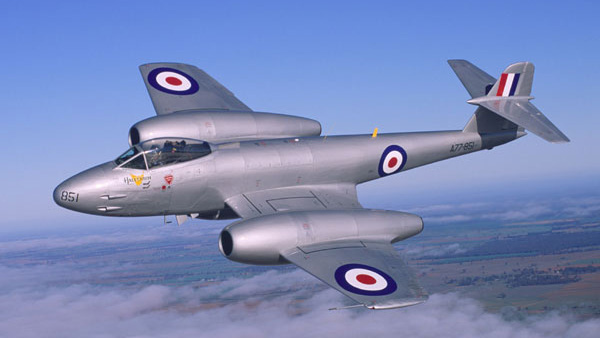 While the war ended with 1,422 Me 262s produced, only a fraction of Meteors were completed in that time. A production order of 210 Meteor F.Mk IIIs was issued in 1944, but the bulk of these were built too late to see service during the war. Unlike the Bell P-59 Airacobra and Messerschmitt Me 262 which would be shelved after the war, production of the Meteor would continue until 1954.3 The Meteor would also see service in the Korean War and it would serve with many countries around the world. A wide array of variants were built and it would remain in service in Ecuador as late as the 1980s. The Jet Age Begins Although Frank Whittle of the United Kingdom and Hans von Ohain of Germany were simultaneously and independently working on the turbojet engine, Germany would be first in flight with jets with the introduction of the Heinkel He 178 on August 27, 1939. The next jet aircraft to take flight was the Gloster E.28/39 (G.40) on May 15, 1941. Both jets were powered by a single engine built for experimental purposes and not meant for production, although the E.28/39 design required provisions for possible later installment of armament. The next true turbojet airplane to take fight was the Messerschmitt Me 262 on July 18, 1942—the Bell XP-59 made its first flight on October 2, 1942—finally the Meteor prototype made its first flight on March 5, 1943. Although the Me 262 flew before the Meteor, it entered frontline service only after the Meteor had done so.4
 DG202 was the first Gloster F.9/40 Prototype and is on display at the Royal Air Force Museum in London. In 1940, the Air Ministry issued the specification F.9/40 for a jet powered fighter. Due to the low output of the Whittle engine, Gloster offered a twin engine design with the company designation G.41. The proposal was approved in November 1940 and twelve prototypes were ordered, but only eight were completed. The Meteor Project Nearly Dies The original engine that powered the Meteor was designed by Power Jets, which was primarily a development company and lacked manufacturing capability to produce engines on a large scale and an experienced manufacturer was needed to produce the large number of engines that would be required. To satisfy the demand, the Air Ministry recommended that Power Jets join up with the Rover car company in joint development of the W.2 Whittle engine. As it turned out, a dispute erupted between the two companies, especially after Rover had made fundamental changes to Whittle's pioneering design in secret without notifying Power Jets. After Rover’s engineers began pursuing their own design, they stopped cooperating with Whittle and his suggestions were largely ignored. As Rover began to understand the workings of the turbojet engine, it became apparent that there were fundamental shortcomings in Whittle’s design and Rover began a new approach. Whittle’s original design incorporated a reverse-airflow configuration, which complicated not only the manufacturing process, but also limited airflow through the engine. Rover looked at it from a long term approach, and came up with a new design that would both simplify construction and increase airflow. This would eventually become the Rolls Royce Derwent engine. However, Rover’s straight-flow design required a reconfiguration of almost the entire engine, and by not completing the design that Whittle had started, delays occurred. Rover’s new design experienced persistent surging and turbine blade failures. This was an area in which Whittle already had experience, but since the two companies were not working together, virtually no progress was made on the W.2 engine. The disagreement resulted in almost two vital years of development lost.
 The single engine Gloster E.1/44 Ace almost replaced the Meteor. Due to delays with the W.2 engine, the Air Ministry showed its frustration by actually canceling the Meteor and the order for the F.9/40 prototypes was reduced to six. With the production aircraft program canceled, the Air Ministry had issued a replacement specification E.5/42 for a single-engine jet fighter. However, with the first successful flights of the F.9/40, the plan was abandoned, but Gloster continued work on the design and submitted a proposal for an updated specification E.1/44. It was powered by a 5,000 lbf (22.24 kN) de Havilland H.1 engine and was designated as the Gloster E.1/44 Ace. Three prototypes were ordered, but they were not completed until after the war. The Ace did not go into production, but a redesigned tail on the third prototype created a breakthrough in performance, and this feature was incorporated into the future model, the F.Mk 8.5 Ernest Hives, head of Rolls-Royce's aero engine division, saved Britain's jet program from disaster. He took Rover's chief engineer, Maurice Wilks, to dinner and did some horse-trading. Wilks had said that he was not happy working with Frank Whittle, so Hives replied, "I'll tell you what I will do. You give us this jet job and we'll give you our tank-engine factory in Nottingham."6 Rolls Royce wanted to build jet engines after the war, because they knew the market would be flooded with Merlin engines. Whittle had revolutionized the aero-engine business making the Merlin obsolete. Rolls Royce put over 2,000 people to work on the W.2B and in January 1943, Rolls Royce logged nearly 400 hours of testing, nearly ten times what Rover had completed the previous month. The turbine blade situation was finally corrected by using alloys of nickel-chromium, Nimonic 80, and by creating stiffer and using fewer blades. Meanwhile, de Havilland was making greater progress on the H.1 Halford engine, which provided 1,500 lbf (6.62 kN) static thrust (s.t.). It was installed in the fifth prototype and it provided enough power to get the Meteor off the ground. Due to delays with the W.2B Whittle engines, the H.1 was used for the first flight of the Meteor on March 5, 1943. The H.1 would serve as the basis for the future Goblin jet engine, which was later used successfully on the de Havilland Vampire. After the W.2B had improved enough to provide suitable power of 1,700 lbf. (7.56 kN) s.t., it was installed in the fourth prototype. Despite the superiority of the H.1 and Derwent engines, the W.2B engine would be selected to power the first production order of twenty F.Mk Is with the company designation G.41A. With the W.2B problems resolved, the number of prototypes was increased to eight.
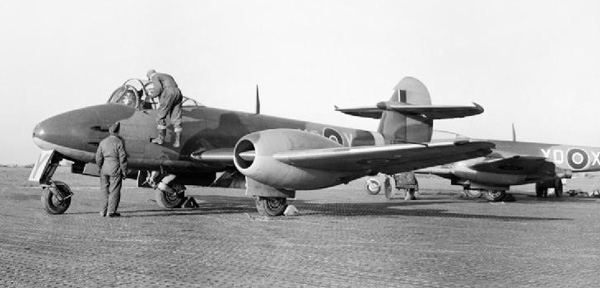 An F.Mk I Meteor of the RAF No. 616 Squadron. The first flight of the production F.Mk I Meteor was on January 12, 1944. It was powered by a Rolls Royce W.2B/23C engine and armament consisted of four 20 mm Hispano cannons, being reduced from the initial requirement of six. Sixteen F.Mk Is entered service with the RAF, while the remaining four were held for trials. Although the F.Mk I was no faster than contemporary fighters, it did have one advantage. It could maintain speed at low altitude and it was pressed into service to intercept V-1 buzz bombs. The first production Meteor was sent to the United States for evaluation in exchange for a Bell YP-59, but British pilots found that the YP-59A performance was unsatisfactory when compared to the Meteor. The Airacomet flew only eleven times at Farnborough and it was returned to the United States in early 1945.7 The Meteor Enters Service The Meteor F.Mk I entered service with No. 616 Squadron, which had been a Spitfire unit based at the RAF base at Culmhead. This was some months before the Me 262 entered service which was not until October 1944. This qualified the No. 616 as the world’s first operational jet fighter squadron. On August 4th, Flying Officer “Dixie” Dean scored the Meteor’s first kill by tipping a V-1 flying bomb after his guns had jammed. On the same day, Flying Officer Roger shot down another V-1 using his guns in the conventional way. The squadron eventually accounted for fourteen V-1 bombs destroyed before the launch sites were overrun. No. 616 Squadron exchanged its F.Mk Is for the first Meteor F.Mk IIIs on December 18, 1944.
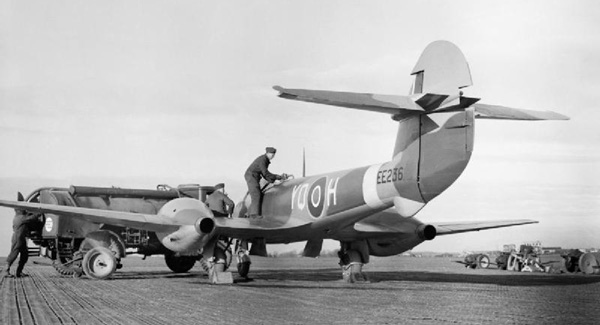 An F.Mk III Meteor of the RAF No. 616 Squadron at Manston, Kent, January 4, 1945. Most V-1s were shot down by gunfire from an optimum range of 200 yds. (180 m), which provided a marginal safe distance for the attacking aircraft. However, many planes were damaged and several pilots killed when the aircraft flew through the debris or after the V-1's bomb exploded. Another option was tipping the V-1. The least dangerous, but most effective method was to disturb the airflow of the wing of the V-1 by sliding the wingtip of the attacking aircraft to within 6 in (15 cm) of the lower surface of the V-1's wing. This would tip the V-1's wing up, overriding the gyros and sending the V-1 into an out-of-control dive. At least sixteen V-1s were destroyed this way. The Hawker Tempest was the most successful in attacking V-1s, but fewer than 30 Tempests were available at the time. The F.Mk I was used to familiarize the USAAF bomber crews with jet fighter tactics before No. 616 Squadron moved to RAF Colerne to re-equip with F.Mk IIIs in December 1944. Four aircraft were detached to Melsbroek in Belguim. They later moved to Gilze-Rijen where they were joined with the rest of the squadron. Thereafter, they were limited to the air defense role so as not to be shot down in enemy-held territory. Four Meteors engaged Focke-Wulf Fw 190s, but were forced to break off after being intercepted by Spitfires and Tempests. On May 2, 1945, a single Meteor forced down a Fieseler Storch and then destroyed it on the ground. By the end of the war, Meteors destroyed 46 German aircraft through ground attack. Flying the Meteor The Meteor was actually an easy plane to fly, making the transition from piston-aircraft to jet-aircraft go rather smoothly. They proved to be as reliable as Spitfires and Tempests and even operated in some cases from grass fields. However, there were some complaints, but these were few. The aircraft hadn’t been cleared for aerobatic maneuvers and the ailerons were deliberately rigged to be "heavy", to prevent overstressing the wings. It also tended to "snake" at high speed, limiting its accuracy as a gun platform. In a dive, it encountered compressibility buffeting and could be become uncontrollable, which was common with many piston aircraft at the time, but only one Meteor broke apart during a dive.
 An F.Mk I Meteor of the RAF No. 616 Squadron. This was in sharp contrast with the Me 262, which was not fully developed and deficient in a key number of areas. The German fighter took a relatively high toll in pilots, which created an urgency to develop a two-seat trainer and required the need for a dedicated training unit. Although faster than any other fighter, over 100 Me 262s were destroyed by P-51 Mustangs and P-47 Thunderbolts of the US 8th and 9th Air Force, and 20 were destroyed by Tempests and several more by Spitfires. Another German jet, the Heinkel He 162, had the worst safety record of all the early jet aircraft. This was in part to its being rushed into production, before the prototypes were completed. It’s been said that the He 162 inflicted more casualties on German pilots than the enemy. Of the 65 factory pilots assigned to He 162s, only five were left at the end of the war. None were lost to combat—they died or crashed during ferry flights or learning to fly them.8
 No. 616 Squadron Meteors were painted white for recognition purposes. In sharp contrast, No. 616 Squadron suffered only two Meteor losses in a mid-air collision due to poor visibility. The biggest threat to the Meteor was being shot down by friendly fire and they were painted white for recognition purposes. No.616 Squadron was disbanded in August of 1945, reforming again two years later with de Havilland Mosquitoes and F.Mk III, F.4 and F.8 Meteors. The squadron was finally disbanded in 1957. Postwar Service The first three-jet fighter squadron wing was formed at Brentwaters in April 1946 after the war with Nos. 56, 74 and 245 Squadrons. A second wing was formed soon after with Nos. 222, 234 and 263 Squadrons. Meteor F.Mk 4s and F.Mk 8s formed the backbone of the RAF until they began being replaced by Hawker Hunters in 1954. The last day-fighter squadron was No. 245, which flew their Meteors until April 1957. The Meteor replaced the de Havilland Mosquito in the night-fighter role until it was replaced by Gloster Javelins from 1957-58. Meteor F.Mk.8s saw extensive service during the Korean War with No. 77 Squadron Royal Australian Air Force (RAAF). The squadron was originally equipped with North American F-51D Mustangs, but in order to match the performance of the MiG-15 jet fighter, the No. 77 Squadron was to be equipped with jet fighters. They were hoping to be equipped with F-86s and Hawker Hunters, but to their dismay they were given Meteors, which were already outclassed by the MiG-15. Operations began on July 29, 1951, but although they were mainly trained for ground attack, they were assigned bomber escort duties. On August 29, 1951, eight Meteors were sent to escort B-29 Superfortresses in "MiG Alley" and engaged six MiG-15s. One Meteor was lost and two were damaged without a single victory for the No. 77 Squadron. On October 27th, No. 77 scored its first probable plus two probables six days later. On December 1st, twelve Meteors mixed it up with forty MiG-15s and the squadron scored two victories, but lost four Meteors.
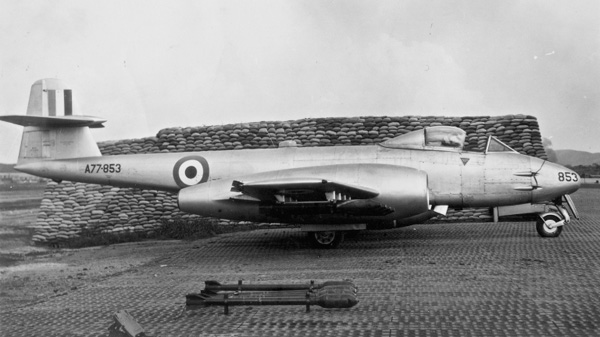 An F.Mk 8 Meteor of the RAAF No. 77 Squadron in Korea. (Note the long nacelles.) By the end of 1951, No. 77 Squadron was relegated to the ground attack role duties. Most were fitted with a radio compass, with a ventral antenna in a small dome. Its durable construction made it more favorable for this type of operation where it was less likely to encounters MiGs. The last encounter with a MiG-15 was in March 1953 in which Sergeant John Hale recorded a victory. In Korea, Meteors completed 4,836 missions and destroyed six MiGs, 3,500 structures and 1,500 vehicles. 30 Meteors were lost in the conflict with most losses due to anti-aircraft fire during ground attacks. The Meteor had to be held smooth and level on its firing run for its gyro-stabilized gunsight to be accurate, making the aircraft vulnerable to ground fire.
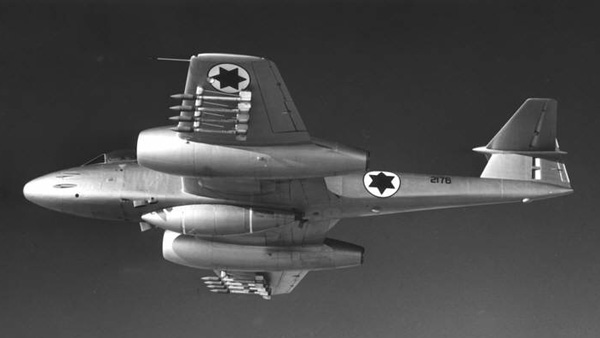 An F.Mk 8 Meteor of the Israeli Air Force. RAF Meteor PR.9s saw extensive use in the 1956 Suez Crisis, and Middle Eastern Meteors of various types saw intermittent combat through the 1950s. On September 1, 1955, an Israeli Meteor shot down an Egyptian de Havilland Vampire, which was the first jet aircraft to be shot down in the Middle East. On October 29, 1956, an Israeli NF.Mk 13 took part in Operation Tarnegol, in which it successfully located and shot down an Egyptian Ilyushin Il-14 that had been carrying several high-ranking Egyptian Military officers on the eve of the crisis. Israel recognized that the Meteor was outclassed by Egyptian MiG-15s, and operations were curtailed. F.Mk.8s remained in front line service until 1956, and were then relegated to the training role. NF.Mk 13s remained in operational use, until 1962.
 F.Mk 4 Meteors of the Argentina Air Force. 100 Meteors were procured by Argentina in 1947 and saw action during political unrest in 1955. At least two were lost, but Meteors remained in service into the early 1970s. Brazil ordered sixty new Meteor F.Mk 8s and ten T.Mk 7 trainers in October 1952. Short on cash, they exchanged 15,000 tons of raw cotton as payment for the Meteors. The Forgotten Hero When World War II ended, 1,422 Me 262s were produced, but production ended except for twelve aircraft built by Avia of the Czechoslovak Air Industry after the war. Whereas, Meteor production continued until 19549 with a total of 3,947 Meteors produced and it served with ten air forces worldwide up until the 1980s. Despite the Meteor’s greater numbers, longer service and reliability, it was largely forgotten. Ironically, it was the dangerous and discontinued Me 262 that is well remembered.
The Meteor F.Mk I A production order of the F.90/40 was placed in in September 1941and was allocated the name Thunderbolt, but the name was changed to Meteor to prevent confusion with the already famous Republic P-47 Thunderbolt.
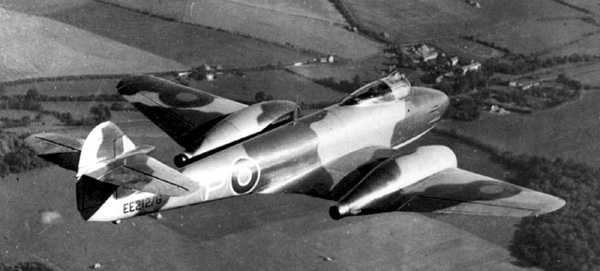 Four Meteor F.Mk Is were retained for trials. EE212/G above had a reduced rudder area and no lower fin. The aircraft was built in sections so that manufacturing could be disbursed during wartime. The fuselage was all-metal stressed-skin construction, built in three sections around a combination of four light-alloy and steel longerons. The tail was built as a complete unit and the wings were built using two light-alloy and steel spars. There were no air brakes, and the canopy opened sideways, as on the F.9/40. The first production aircraft, EE210/G, was delivered to the USA in exchange for a Bell P-39 Airacomet. The P-39 flew only eleven times at Farnborough and it was returned to the United States in early 1945. The F.Mk I was not much different from the F.9/40 prototype and it was powered by two Rolls-Royce W.2B/23C Welland series turbojets producing 1,700 lbf (7.56 kN) s.t. each. It had a maximum speed of 410 mph (660 km/h), range was 500 miles (805 km) and a service ceiling of 34,000 ft. (10,360 m). The rate-of-climb was 2,155 ft/min (10.95 /sec) with the ability to climb to 30,000 ft. (9,145 m) in 9 minutes. Originally 300 F.Mk I Meteors were ordered, but this was reduced to twenty as more advanced models were anticipated. Sixteen were delivered to No. 616 Squadron and four were retained for trials.
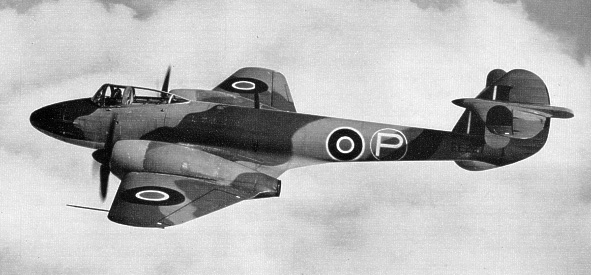 Production Meteor EE227 was the world’s first turboprop airplane. The eighteenth production aircraft, EE227, was converted to take two Rolls-Royce RB 50 Trent turboprops with 7 ft. 11 in. (2.41 m) five-blade Rotol propellers. Its inaugural flight was on September 20, 1945 making it the world’s first turboprop airplane. The landing gear was lengthened to allow for tip clearance for the propellers. Power output was a combination of 750 shaft horsepower (1, 000 kW) and 1,000 lbf (4.44 kN) s.t. With all the modifications, it was the heaviest F.Mk I produced. The Meteor F.Mk II The sixth prototype, DG207/G, was powered by a de Havilland H.1 due to the long delay of the Rover W.2B engine. The H.1 powered the first flight of the Meteor on March 5, 1943. The F.Mk II never went into production, because this would have interfered with the future allocation of Goblin engines for the de Havilland Vampire. The Meteor F.Mk III The F.Mk III was the first Meteor to be built on large production scale. 210 aircraft were built after a production order was issued in 1944, but the bulk of these were built too late to see service during the war. However, a few early F.Mk IIIs did enter service with No. 616 Squadron at Manston. The first fifteen F.Mk IIIs differed from the F.Mk I in having a sliding canopy in place of the sideways hinging canopy, increased fuel capacity and some airframe modifications, but were still powered by Welland W2B/23C engines. The remaining 195 production aircraft were powered by 2,000 lbf. (8.89 kN) s.t. Rolls Royce Derwent engines.
 Meteor F.Mk IIIs with the original short engine nacelles. Following tests on EE211/G, the last fifteen aircraft were fitted with long-chord nacelles. Wind tunnel tests showed that the short nacelles contributed heavily to compressibility buffeting at high speed. Both the front and aft portion of the nacelle was lengthened which reduced buffeting and increased speed by 75 mph (120 km/h). Some earlier Meteor F.Mk IIIs were also retrofitted in the field as well. Wellend powered F.Mk IIIs were delivered to No. 616 Squadron in January 1945 at Manston and one flight went to the 2nd Tactical Air Force in Belgium. After the war, F.Mk IIIs equipped No. 504 Squadron. Derwent powered F.Mk IIIs were sent to Fighter Command’s first jet fighter wing of Nos. 56, 74 and 245 Squadrons at RAF Bentwaters and a second wing was equipped at Boxted. Thirty F.Mk IIIs were used for trials and several were used to test the Martin Baker ejection seat. EE445 was used to test the Griffiths wing for boundary layer control tests and EE337 and EE 387 were used for carrier deck landing trials. EE337 and EE 387 were powered by short nacelle 3,000 lbf. (13.34 kN) s.t. Derwent 5 engines. In 1950 during landing tests on the HMS Implacable, the Meteor was said found to have better deck-handling capabilities than other jet tested at that time. In September 1945, F.Mk IIIs were the first jet aircraft to be used for tropicalization trials at Khartoum and the first winterization trials at Edmonton, Canada in 1946. EE379 was fitted with a nose probe for inflight refueling and set an endurance record of 12 hours, 3 minutes on August 7, 1949. The Meteor F.Mk 4 The Meteor F.Mk 4, designation changed with the RAF having switched from Roman to Arabic designation numbers, although it started out as the F.Mk IV. The F.Mk 4 was powered by two Rolls Royce Derwent 5 engine with a s.t. of 3,500 lbf (15.56 kN). The Derwent 5 was a scaled down version of the 5,000 lbf (22.24 kN) s.t. Rolls Royce Nene which powered the Supermarine Attacker. Total power was increased from 4,000 to 7,000 lbf (17.79 kN to 31.13 kN) s.t. which created a dramatic improvement in performance. The F.Mk 4 also featured the lengthened engine nacelle which became standard on most of the subsequent models.
 RAF F.Mk 4 Meteors with long nacelles. This wasn’t the only improvement to the Meteor. The cabin was also pressurized, which became a necessity now that the airplane could climb to 40,000 ft (12,200 m) in 8 minutes. Underwing tanks were added to increase ferrying range and bombs and rockets could be carried under the outer wings. The underwing armament paved the way for the ground attack role of the F.Mk 8s in Korea. A geared aileron tab was also added to improve handling. The most distinctive feature of the F.Mk 4 was the clipped wings. This modification was incorporated after a tragic accident where a pilot miscalculated recovering from a dive and the aircraft broke up. More than likely the aircraft encountered compressibility and became uncontrollable. The wing span was reduced by 5 ft. 10 in. (1.77 m) to prevent overstressing of the center wing spar and the wing modification was performed retroactively on 100 earlier F.Mk 4s. The shortened wing increased the roll rate by more than 80 degrees per second, but it also increased landing and takeoff speeds. Other changes included a strengthened airframe and 325 gallons (1,230 liters) of internal fuel. As modifications increased, ballast was added to the nose and heavy alloy rings were installed in the engine nacelles, to maintain the proper center of gravity (c.g.). Ballast totaled 1,000 lbs. (455 kg). During the autumn of 1945, two late model F.Mk IIIs were modified to F.Mk 4 standards and used for an attempt to break the world's air speed record. The aircraft was stripped down of all military equipment, the structure was strengthened at various locations, and the exterior was highly polished. Aircraft EE454, named Britannia, was painted in normal RAF camouflage and was flown by G/C. H. J. Wilson. EE455, known as the “Yellow Peril,” was flown by Gloster test pilot Eric Greenwood. A third F.Mk 4 was used as a high-speed practice aircraft. On November 7th, 1945, G/C. Wilson succeeded in breaking the speed record over a 3-km course at Herne Bay, Kent, with a speed an average speed of 606 mph (975 km/h). On the same day, Eric Greenwood achieved a speed of 603 mph (970 km/h).
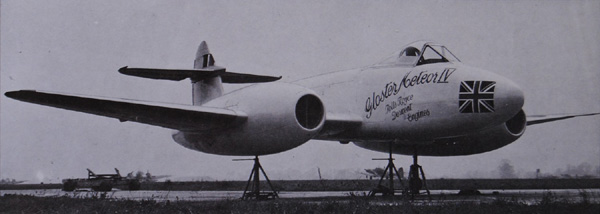 An F.Mk 4, EE455, was painted yellow and broke a speed record averaging 606 mph (975 km/h). In 1946, a second attempt was made with two special Meteor F.Mk 4s were prepared for an RAF High Speed Flight. Known as "Star Meteors," they were numbered EE549 and EE55O. Their Derwent engines were upgraded to deliver 4,200 lbf. (18.68 kN) s.t., and the Perspex (Plexiglass) cockpit canopies were replaced by metal canopies with small Perspex inserts for visibility. The normal canopies tended to deform in flight. On September 7th, 1946, G/C. E. M. Donaldson, in EE549, raised the record to 616 mph (991 km/h) and EE55O, flown by S/L. W. A. Waterton achieved a speed of 614 mph (988 km/h). The third member of the High Speed Flight was F/L. Neville Duke.
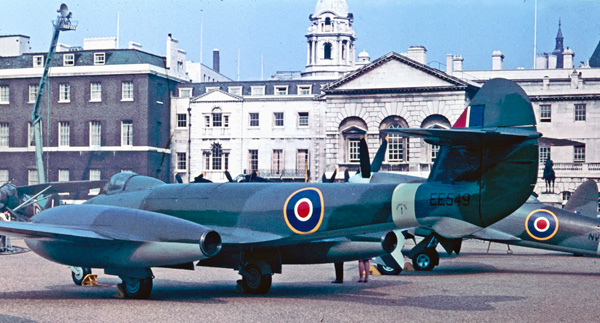 "Star Meteor" EE549, raised the world's speed record to 616 mph (991 km/h). A total of 535 Meteor F.Mk 4s were built for the RAF, with 48 of built by Armstrong-Whitworth. A large number were built for export with 100 going to Argentina in 1947, 48 to Belgium, 20 to Denmark, 12 to Egypt and 38 to the Netherlands. The Dutch later obtained 27 additional used F.Mk 4s from the RAF. France obtained two aircraft as test-beds for Atar turbojets. The Meteor FR.Mk 5 This was an experimental fighter-reconnaissance version and only one prototype was produced. The design was an attempt to eliminate previous icing-up of reconnaissance cameras installed on earlier F.Mk III and F.Mk 4 aircraft. The airframe, VT347, was a converted F.Mk 4 and had two F.36 vertical cameras installed in the rear fuselage and one F.24 oblique camera installed in the nose. The nose camera could be set on the ground for left, right or forward oblique photography through three windows in a modified nose section. The first flight was on June 15, 1949, but ended in disaster when the aircraft crashed at Moreton Valence, killing Gloster test pilot Rodney Dryland. The cause of the accident was traced to a failure of the center-section after a high G pull-up over the field. Modifications, to strengthen the fuselage, were incorporated into future designs as a result of the accident. The Meteor T.Mk 7 Vast numbers of jet aircraft were coming online after WWII, which created a need for jet trainers. To meet the demand, Gloster produced a two-seat unpressurized trainer which was basically an F.Mk 4 with an extended forward fuselage. It was a private venture for Gloster, designated the T.Mk 7, and designed by a team working under the direction of R. W. Walker. The forward fuselage was extended by 30 inches (76 cm) to accommodate a second pilot in tandem, it had dual controls and was unarmed. The first flight was on March 19, 1948, piloted by Bill Waterton.
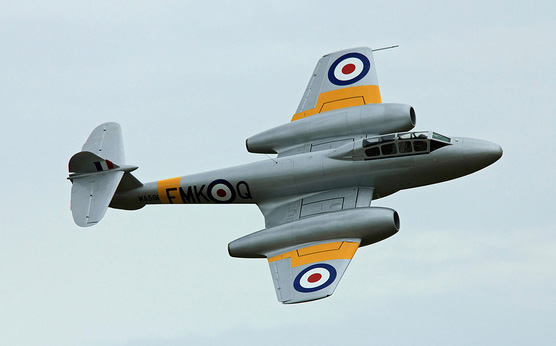 The Meteor T.Mk 7 trainer. Directional control has always been a problem with the Meteor. It was found that the lengthened fuselage corrected this issue and it was incorporated in all future variants of the Meteor. Provisions were made for a 175 gallon (660 liter) ventral drop tank and two 100 gallon (380 liter) wing drop tanks. The 1,000 lb. (455 kg) ballast was reduced to 462 lbs. (210 kg) and then to 300 lbs. (135 kg) after additional modifications. The total weight dropped by 350 lbs. (158 kg) which made the takeoff performance somewhat better than the fighter variants. The original engine was the Derwent 5 but it was later powered by the Derwent 8 with larger engine inlets. The performance was impressive enough for the Air Ministry to issue specification T.1/47 to constitute a version for the RAF. A total production of 640 T.Mk 7s were produced between 1949 and 1954. The first T.Mk 7 production trainers were supplied to No. 203 Advanced Fling School at Drillfield and 96 other RAF and RN squadrons, as well as various training units. Export orders totaled 72 and were flown by the Netherlands, Belgium, Egypt, Syria Denmark, Brazil, France, Israel and Sweden. The Meteor F.Mk 8 The F.Mk 8 was the variant produced in the greatest numbers and was the mainstay single-seat day interceptor for the RAF from 1950 until 1954. It was considered an interim fighter in anticipation of being replaced by the Hawker Hunter and Supermarine Swift. Development began in 1947, but being outclassed by a new series of jet fighters, improvements were needed to make it more competitive. The lengthened forward fuselage, which had been used earlier on the T.Mk 7 increased longitudinal stability and this became a standard feature. 95 imperial gallons (430 liters) of fuel was carried in the 30 inch (76 cm) extension, however, after fuel and armament was expended, the c.g. moved beyond acceptable limits. This was partly offset by removing 275 lbs. (125 kg) of lead ballast from the 15 inch (38 cm) webs adjacent to the cannons, but the c.g. problem was finally resolved after a redesigned tail was installed, that had been previously tested on the third prototype of the E.1/44 Ace. The new tail corrected pitch stability issues and eliminated the need for ballast installed on earlier models. With the ballast gone, additional fuel could be carried, which increased range.
 The Meteor F.Mk 8 had a redesigned tail. It was powered by the 3,500 (15.57 kN) s.t. Derwent 8 and had a large one piece sliding canopy with a metal rear fairing on earlier models. The spar webs and center-section were strengthened using high tensile steel to meet the demands of higher performance. The Martin-Baker Mk 1 or Mk 1E ejection seat was standard on all aircraft. Some ejection seats were later upgraded to Mk 2E standards allowing for escapes as low as 125 ft. (38 m). It had a retractable gyro gunsight, new wingroot fillets and a stronger landing gear developed on the NF.Mk 11 night-fighter. The maximum level speed increased to 592 mph (958 km/h) at sea level, but it did not climb as fast as the long-span F.Mk 4. The F.Mk 4 could climb to 30,000 ft. (9,144 M) in five minutes, and the F.Mk 8 required 6-1/2 minutes. The armament was the same as earlier models with four 20 mm British Hispano cannons. It was discovered that pilots laying in the prone position could handle higher g-forces than if they sat upright in the cockpit. To counteract inertial forces, an Meteor F.8 was modified by Armstrong Whitworth with a forward second cockpit, to place the pilot in the prone position. The first flight was on February 10, 1954. However, improvements in pressurized g-suits, which had been introduced in World War II, provided a simpler solution and the concept was dropped. The F.Mk 8, S/N WK935, is preserved at the RAF Museum at Cosford. A total of 1,183 F.Mk 8s were built by Gloster and Armstrong-Whitworth with the first production F.Mk 8 was delivered to No. 1 Squadron at Tangmere on December 10, 1949. They equipped 32 RAF Squadrons and 11 RAAF squadrons. 89 F.Mk 8s serve with distinction in Korea with the RAAF. 50 aircraft were refurbished for export. The Meteor FR.Mk 9 The FR.Mk 9 fighter-reconnaissance version was developed from the F.Mk 8 to replace the aging Spitfire XVIIIs. 126 FR.Mk 9s were built by Gloster for the RAF and equipped with a F.24 nose camera intended for the FR.Mk 5. Three panels in the nose allowed for left, right or forward oblique photography, which could be operated by the pilot with a type 48 controller. The camera was heated from bleed air from the starboard Derwent 8 engine. Normal armament consisted of four 20 mm cannons. The first squadron to be equipped was No. 208 on July 28, 1940. The majority of the squadrons equipped with the FR.Mk 9 were based in the Middle East and with the 2nd Tactical Air Force in Germany. The airplanes were later sold to Ecuador, Israel and Syria. The Meteor PR.Mk 10 The PR.Mk 10 served as a high-altitude photo-reconnaissance platform. 59 PR.Mk 10s were built for the Royal Air Force. NF.Mk 11 thru NF.MK 14
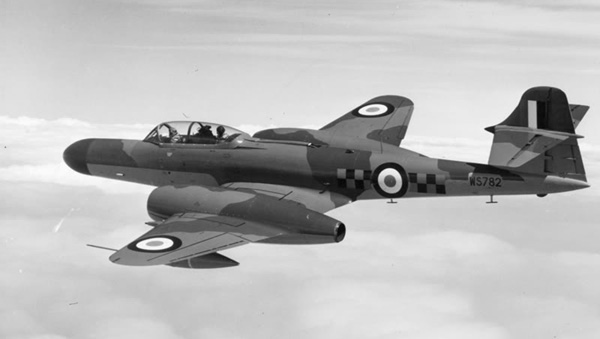 The elongated nose of the Meteor night-fighters housed an airborne intercept radar system.
Gloster F.9/40 Prototype Engines Four different engines were installed in the F.9/40 prototypes:
 The Rolls Royce W.2B/23 Welland reverse-flow engine.  The Rolls Royce Derwent straight-flow engine.  The Metropolitan-Vickers F.2 axial-flow engine.  The de Havilland H.1 straight-flow engine.
|

|
Specifications: | ||
|---|---|---|---|
| Gloster Meteor | |||
| Dimensions: | |||
| F.Mk I | F.Mk III | F.Mk 8 | |
| Wing span: | 43 ft 0 in (13.10 m) | 43 ft 0 in (13.10 m) | 37 ft 2 in (11.02 m) |
| Length: | 41 ft 3 in (12.57 m) | 41 ft 3 in (12.57 m) | 44 ft 7 in (13.58 m) |
| Height: | 13 ft 0 in (3.96 m) | 13 ft 0 in (3.96 m) | 13 ft 0 in (3.96 m) |
| Weights: | |||
| Empty: | 8,140 lb (3,692 kg) | 8,810 lb (3,996 kg) | 10,684 lb (4,846 kg) |
| Loaded Weight: | 11,800 lb (5,352 kg) | 13,300 lb (6,032 kg) | 15,700 lb (7,121 kg) |
| Performance: | |||
| Maximum Speed Sea Level: | 385 mph (620 km/h) | 458 mph (737 km/h) | 592 mph (952 km/h) |
| Maximum Speed 30,000 ft: | 410 mph (660 km/h) | 493 mph (793 km/h) | 550 mph (885 km/h) |
| Service Ceiling: | 40,000 ft (12,190 m) | 44,000 ft (13,410 m) | 43,000 ft (13,100 m) |
| Range: | 1,340 miles (2,155 km) | 1,340 miles (2,155 km) | 690 miles (1,110 km) |
| Powerplant: | Two 1,700 lbf (7.56 kN) s.t. Rolls-Royce Wellend I. |
Two 2,000 lbf (8.89 kN) s.t. Rolls-Royce Derwent I. |
Two 3,500 lbf (15.56 kN) s.t. Rolls-Royce Derwent 8. |
| Armament: | Four 20 mm Hispano Mk.III Cannon. | Four 20 mm Hispano Mk.III Cannon. | Four 20 mm Hispano Mk.III Cannon. |
Endnotes:
|
Return to Aircraft Index
©Larry Dwyer. The Aviation History Online Museum.
All rights reserved.
Created August 1, 2015. Updated April 24, 2020.